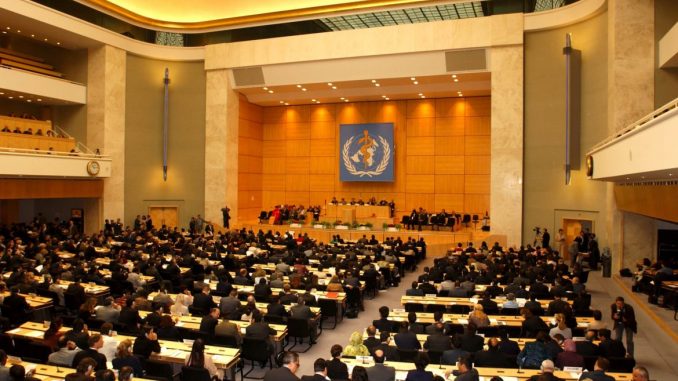
Table of Contents
What is World Health Assembly (WHA)?
- World Health Assembly simply means the gathering of representatives from all the WHO member states where they discuss particularly on the conundrums of global health along with the ways to combat health issues through focusing more on specific health agenda prepared by the Executive Board. (2)
- The World Health Assembly is the decision–making body and an important medium of World Health Organization (WHO) through which its 194 member states are governed. (1)
- The World Health Assembly first meeting held on 22 July 1946 in Geneva, Switzerland.
- WHA is attended by delegations from all WHO member states and is focused on particular health agenda.
- The members of the WHA usually meet every year (annually) in May in Geneva; headquarters of WHO were delegations from all the WHO Member States attends the assembly. (1)
- The main objective of the World Health Assembly is to define and formulate the health policies of the organization, engage the Director-General, supervising-monitoring financial strategies, review/approve the projected program budget.
Major functions of WHA:
- To determine policies of the organization
- To appoint Director-General of WHO
- To supervise financial policies
- To review and approve proposed budget of the programs
Importance of WHA in global health:
- World Health Assembly plays a vital role in global health, through collaboration with the numerous health entities all over the world working for the betterment of humankind in a meteoric phase.
- WHA in a global platform shows the importance of Global Mental health to the diverse communities, through organizing programs in cooperation with Global Public Health Education and training.
- WHA introduced the second model World Health Assembly in alliance with the office of International Affairs for the Health assortment where people participated in the model assembly and discussed, debated on the issue of global mental health. (1)
- Likewise, annually WHA creates health resolution where it addresses trending and challenging health issues that have changed the global health landscape.
How does WHA take place?
- The WHA takes place every year in the month of May at the United Nations in Geneva, Switzerland. It is attended by delegations from all 194 WHO Member States. Every year WHA comes up with new health resolutions.
- Until now (June 2019), WHA is held up 72 times with challenging resolutions (3). The 72nd WHA was held on 20-28th May, 2019.
Two main types of the meeting held in WHA each with a different purpose:
- Committeesmeet to debate technical and health matters (Committee A), and financial and management issues (Committee B) and approve the texts of resolutions, which are then submitted to the plenary meeting.(1)
- Plenaryis the meeting of all delegates to the World Health Assembly.(1)
Major stakeholders and participants of WHA:
Major Stakeholders
Diverse global health stakeholders, that include:
- Ministries of Health, government agencies, and other government departments at the national level.
- Health partnerships and WHO collaborating centers.
- United Nations at global, regional and country level. (3)
Participants
- Young individuals/ medical students belonging to various countries to ensure active youth participation and engagement in global health governance. (3)
- Individuals familiar with following the topics:
- Public health and advocacy activities
- State, local, and Tribal issues
- Minority health organizations
- Academic and scientific organizations.
- Youth organizations involvement to support in order to strengthen the voice of youths to prepare strategies and working plan for the World Health Assembly.
Major achievements of WHA till date (May 2019):

The World Health Assembly is the major decisions making the body of the World Health Organizations. Therefore, the achievements of WHO are the achievements of WHA, which are as follows:
- On May 7 2019-WHO adapted Ebola Vaccination Strategy in the Democratic Republic of the Congo to Account for Insecurity and Community Feedback. (4)
- In 2016, WHO released the second edition of the consolidated guidelines on the use of antiretroviral drugs for preventing HIV infection and by the mid-2018 163 countries adopted the recommendation, which resulted the number of people eligible for ART has increased from 28 million to 36.9 million people living with HIV.
- Likewise, WHO is supporting countries to accelerate their efforts to timely diagnose and treat vulnerable population and expand the access to treatment to end the AIDS epidemic by 2030.
- WHA has also focused on ending childhood obesity through various implementation plan in 2017.
- WHA has established noticeable official relations between WHO and the World Federation of Neurological Societies in 2018. This gave the result that global neurosurgery is gaining momentum (5)
- The resolution of WHA60 and Assembly 16 motivated the member states to take major steps on preventing oral cancer and considered it as an integral part of national cancer-control programs (6)
- Involvement of oral- health professionals with relevant training in oral health in detection, early diagnosis, and treatment (6)
- Development of International classification of impairments, disabilities, and handicaps: a manual classification relating to the consequences of disease, in accordance with resolution WHA 28.35 of the Twenty-ninth World Health Assembly, May 1976.
Must remember points about WHA:
- The World Health Assembly is a governing body of the world health organization.
- The World Health Assembly held annually in Geneva, Switzerland attended by delegations from all 194 WHO the Member States.
- The main function of The World Health Assembly is to determine the policies of the organization, appoint the Director-General, supervise financial policies, and review and approve the proposed program budget.
- The World Health Assembly provides a baseline data on health issues and helps in collaboration, advocate and connect between its member states and the participants of the assembly.
References and For More Information:
1.World Health Assembly. 2019.
2. Ferguson SL. The World Health Organization’s Sixty-Eighth World Health Assembly: Updates and Opportunities. Nursing economic$. 2015;33(4):236-9.
3. Sellers TF. World Health Assembly. Journal of the Medical Association of Georgia. 1952;41(7):309-10.
4. Stakeholders. 2019.
5. Kasereka MC, Sawatzky J, Hawkes MT. Ebola epidemic in war-torn Democratic Republic of Congo, 2018: Acceptability and patient satisfaction of the recombinant Vesicular Stomatitis Virus – Zaire Ebolavirus Vaccine. Vaccine. 2019;37(16):2174-8.
6. Rosseau G, Johnson WD, Park KB, Arraez Sanchez M, Servadei F, Vaughan KA. Global neurosurgery: current and potential impact of neurosurgeons at the World Health Organization and the World Health Assembly. Executive summary of the World Federation of Neurosurgical Societies-World Health Organization Liaison Committee at the 71st World Health Assembly. Neurosurgical focus. 2018;45(4):E18.
7. Petersen PE. Global policy for improvement of oral health in the 21st century–implications to oral health research of World Health Assembly 2007, World Health Organization. Community dentistry and oral epidemiology. 2009;37(1):1-8.
https://www.who.int/about/governance/world-health-assembly
https://www.sciencedirect.com/science/article/abs/pii/S1368837508001760
https://www.ncbi.nlm.nih.gov/pubmed/?term=major+decisions+by+world+health+assembly
https://foodinsight.org/remember-the-people-update-from-the-2011-world-health-assembly/
https://ifmsa.org/youth-pre-world-health-assembly/
https://www.msh.org/blog/2014/05/20/so-why-are-you-attending-the-world-health-assembly
https://healthfinder.gov/FindServices/Organizations/Organization.aspx?code=HR2552
